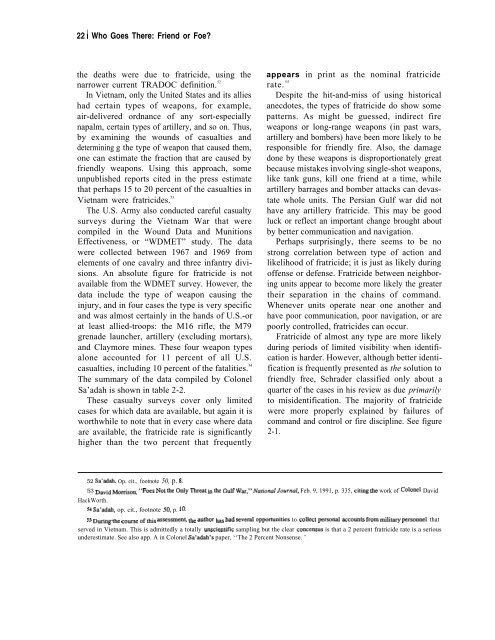Who Goes There: Friend or Foe? - Federation of American Scientists
Who Goes There: Friend or Foe? - Federation of American Scientists
Who Goes There: Friend or Foe? - Federation of American Scientists
Create successful ePaper yourself
Turn your PDF publications into a flip-book with our unique Google optimized e-Paper software.
22 I <strong>Who</strong> <strong>Goes</strong> <strong>There</strong>: <strong>Friend</strong> <strong>or</strong> <strong>Foe</strong>?<br />
the deaths were due to fratricide, using the<br />
narrower current TRADOC definition. 52<br />
In Vietnam, only the United States and its allies<br />
had certain types <strong>of</strong> weapons, f<strong>or</strong> example,<br />
air-delivered <strong>or</strong>dnance <strong>of</strong> any s<strong>or</strong>t-especially<br />
napalm, certain types <strong>of</strong> artillery, and so on. Thus,<br />
by examining the wounds <strong>of</strong> casualties and<br />
determining g the type <strong>of</strong> weapon that caused them,<br />
one can estimate the fraction that are caused by<br />
friendly weapons. Using this approach, some<br />
unpublished rep<strong>or</strong>ts cited in the press estimate<br />
that perhaps 15 to 20 percent <strong>of</strong> the casualties in<br />
Vietnam were fratricides. 53<br />
The U.S. Army also conducted careful casualty<br />
surveys during the Vietnam War that were<br />
compiled in the Wound Data and Munitions<br />
Effectiveness, <strong>or</strong> “WDMET” study. The data<br />
were collected between 1967 and 1969 from<br />
elements <strong>of</strong> one cavalry and three infantry divisions.<br />
An absolute figure f<strong>or</strong> fratricide is not<br />
available from the WDMET survey. However, the<br />
data include the type <strong>of</strong> weapon causing the<br />
injury, and in four cases the type is very specific<br />
and was almost certainly in the hands <strong>of</strong> U.S.-<strong>or</strong><br />
at least allied-troops: the M16 rifle, the M79<br />
grenade launcher, artillery (excluding m<strong>or</strong>tars),<br />
and Claym<strong>or</strong>e mines. These four weapon types<br />
alone accounted f<strong>or</strong> 11 percent <strong>of</strong> all U.S.<br />
casualties, including 10 percent <strong>of</strong> the fatalities. 54<br />
The summary <strong>of</strong> the data compiled by Colonel<br />
Sa’adah is shown in table 2-2.<br />
These casualty surveys cover only limited<br />
cases f<strong>or</strong> which data are available, but again it is<br />
w<strong>or</strong>thwhile to note that in every case where data<br />
are available, the fratricide rate is significantly<br />
higher than the two percent that frequently<br />
52 sa’~~, Op. cit., footnote 50, p. 8.<br />
appears in print as the nominal fratricide<br />
rate. 55<br />
Despite the hit-and-miss <strong>of</strong> using hist<strong>or</strong>ical<br />
anecdotes, the types <strong>of</strong> fratricide do show some<br />
patterns. As might be guessed, indirect fire<br />
weapons <strong>or</strong> long-range weapons (in past wars,<br />
artillery and bombers) have been m<strong>or</strong>e likely to be<br />
responsible f<strong>or</strong> friendly fire. Also, the damage<br />
done by these weapons is disprop<strong>or</strong>tionately great<br />
because mistakes involving single-shot weapons,<br />
like tank guns, kill one friend at a time, while<br />
artillery barrages and bomber attacks can devastate<br />
whole units. The Persian Gulf war did not<br />
have any artillery fratricide. This may be good<br />
luck <strong>or</strong> reflect an imp<strong>or</strong>tant change brought about<br />
by better communication and navigation.<br />
Perhaps surprisingly, there seems to be no<br />
strong c<strong>or</strong>relation between type <strong>of</strong> action and<br />
likelihood <strong>of</strong> fratricide; it is just as likely during<br />
<strong>of</strong>fense <strong>or</strong> defense. Fratricide between neighb<strong>or</strong>ing<br />
units appear to become m<strong>or</strong>e likely the greater<br />
their separation in the chains <strong>of</strong> command.<br />
Whenever units operate near one another and<br />
have po<strong>or</strong> communication, po<strong>or</strong> navigation, <strong>or</strong> are<br />
po<strong>or</strong>ly controlled, fratricides can occur.<br />
Fratricide <strong>of</strong> almost any type are m<strong>or</strong>e likely<br />
during periods <strong>of</strong> limited visibility when identification<br />
is harder. However, although better identification<br />
is frequently presented as the solution to<br />
friendly free, Schrader classified only about a<br />
quarter <strong>of</strong> the cases in his review as due primarily<br />
to misidentification. The maj<strong>or</strong>ity <strong>of</strong> fratricide<br />
were m<strong>or</strong>e properly explained by failures <strong>of</strong><br />
command and control <strong>or</strong> fire discipline. See figure<br />
2-1.<br />
53 David M~rnS~~ ~~FWS Not he CMy hat in he GuM WU,’ Nationul Journa/, Feb. 9, 1991, p. 335, cittig tie w<strong>or</strong>k <strong>of</strong> Colonel David<br />
HackW<strong>or</strong>th.<br />
54 Sa’adti, op. cit., footnote 50, p. 10.<br />
55 D~g tie Coww <strong>of</strong> ~~ ~~e~~ment, tie au~<strong>or</strong> ~ ~d seve~ oppo~ties to coll~t perso~ WCOUIItS from military perSOMel that<br />
served in Vietnam. This is admittedly a totally umcientilic sampling but the clear concensus is that a 2 percent fratricide rate is a serious<br />
underestimate. See also app. A in Colonel Sa’adah’s paper, ‘‘The 2 Percent Nonsense. ’
















